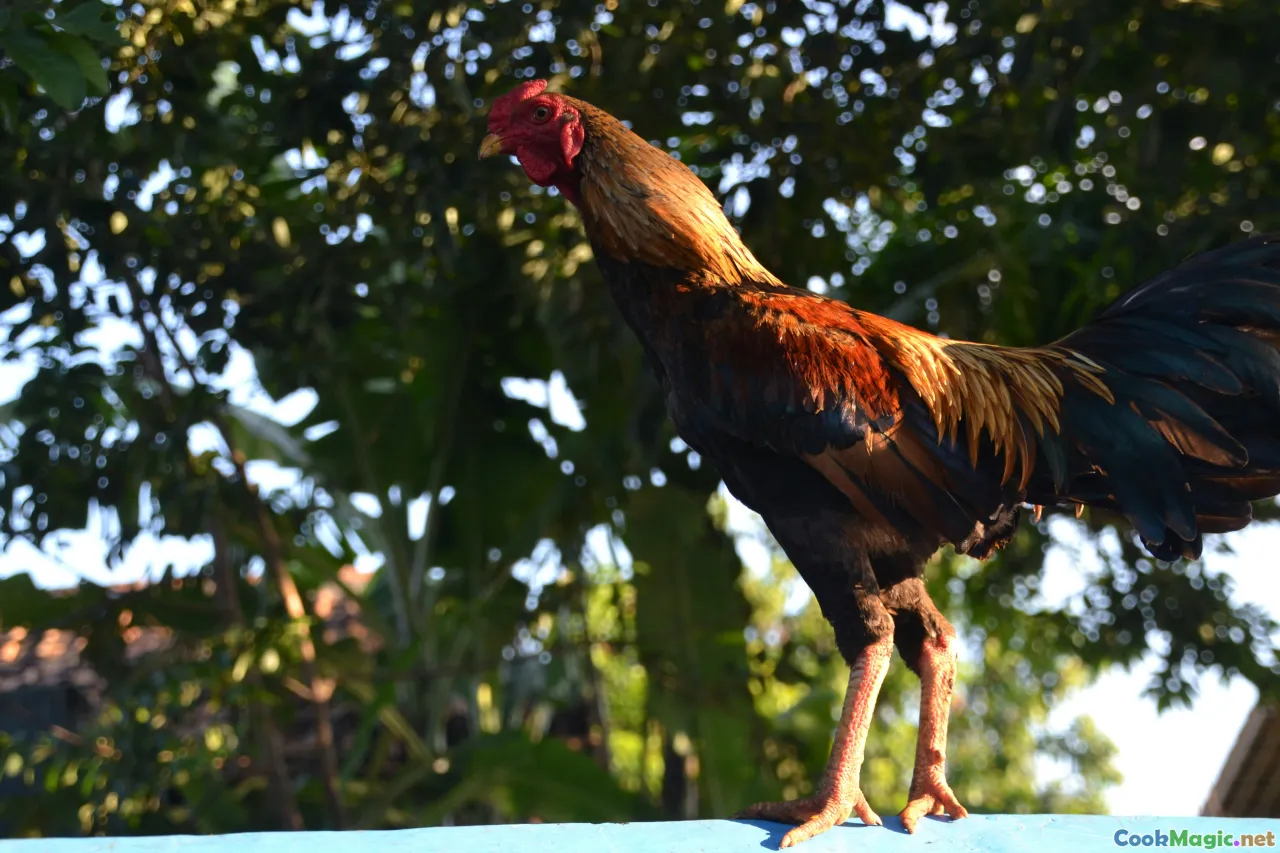
Gà Kho Brazil với Pequi độc đáo và Saffron
(Brazilian Galinhada with Exotic Pequi & Saffron)
(0 Đánh giá)0
1,955
tháng 8 27, 2025
Báo cáo sự cố
Nguyên liệu
-
800 grams Gà đùi gà
(Skin-on, bone-in for flavor)
-
6 whole Quả pequi
(Handle carefully; avoid gnawing the pit)
-
2 cups Gạo dài
(Preferably washed and soaked for 30 minutes)
-
1 large Hành tây
(Băm nhỏ)
-
4 cloves Tỏi
(Nghiền hoặc băm)
-
2 medium Cà chua
(Cắt hạt lựu)
-
1 medium Ớt chuông
(Diced, any color)
-
3 tbsp Dầu Pequi (hoặc dầu thực vật)
(Traditional, substitute with neutral oil)
-
1/4 tsp Saffron
(Can use turmeric as an alternative)
-
1 1/2 tsp Muối
(Nêm theo khẩu vị)
-
1/2 tsp Hạt tiêu đen
-
4 cups nước dùng gà
(Tự làm hoặc ít natri)
-
1/3 cup Ngò rí tươi
(Băm nhỏ, để trang trí)
-
4 pieces Cắt lát chanh tươi
(Dọn lên bàn)
(Skin-on, bone-in for flavor)
(Handle carefully; avoid gnawing the pit)
(Preferably washed and soaked for 30 minutes)
(Băm nhỏ)
(Nghiền hoặc băm)
(Cắt hạt lựu)
(Diced, any color)
(Traditional, substitute with neutral oil)
(Can use turmeric as an alternative)
(Nêm theo khẩu vị)
(Tự làm hoặc ít natri)
(Băm nhỏ, để trang trí)
(Dọn lên bàn)
Dinh dưỡng
- Khẩu phần: 4
- Kích thước khẩu phần: 1 đĩa (350g)
- Calories: 700 kcal
- Carbohydrates: 68 g
- Protein: 35 g
- Fat: 32 g
- Fiber: 6 g
- Sugar: 4 g
- Sodium: 950 mg
- Cholesterol: 110 mg
- Calcium: 80 mg
- Iron: 3.2 mg
Hướng dẫn
-
1 - Marinate Chicken:
Season chicken with salt, black pepper, and half the garlic. Set aside to marinate while prepping other ingredients.
-
2 - Prepare Ingredients:
Carefully wash and soak rice; chop onion, tomato, bell pepper, and coriander; mince remaining garlic.
-
3 - Sear Chicken:
Heat pequi or vegetable oil in a heavy pot. Sear chicken pieces until golden on all sides, about 2–3 minutes per side. Remove and set aside.
-
4 - Sauté Aromatics:
Add onions and sauté until translucent. Stir in remaining garlic, diced bell pepper, and tomatoes. Cook for 5 minutes until soft.
-
5 - Simmer with Pequi:
Return chicken to the pot. Add pequi fruit and stir gently. Simmer briefly to combine and infuse pequi aroma.
-
6 - Add Rice & Saffron:
Drain rice and stir it into the pot. Sprinkle saffron or turmeric over. Sauté for 2–3 minutes until grains are lightly coated and yellow.
-
7 - Cook Rice and Chicken:
Add chicken stock and remaining salt. Mix well. Bring to a boil, reduce heat, cover, and simmer gently until rice is cooked, about 30–35 minutes.
-
8 - Rest and Serve:
Let the pot rest off-heat for 5–7 minutes, then fluff with a fork. Garnish with coriander and serve with fresh lime wedges.
Season chicken with salt, black pepper, and half the garlic. Set aside to marinate while prepping other ingredients.
Carefully wash and soak rice; chop onion, tomato, bell pepper, and coriander; mince remaining garlic.
Heat pequi or vegetable oil in a heavy pot. Sear chicken pieces until golden on all sides, about 2–3 minutes per side. Remove and set aside.
Add onions and sauté until translucent. Stir in remaining garlic, diced bell pepper, and tomatoes. Cook for 5 minutes until soft.
Return chicken to the pot. Add pequi fruit and stir gently. Simmer briefly to combine and infuse pequi aroma.
Drain rice and stir it into the pot. Sprinkle saffron or turmeric over. Sauté for 2–3 minutes until grains are lightly coated and yellow.
Add chicken stock and remaining salt. Mix well. Bring to a boil, reduce heat, cover, and simmer gently until rice is cooked, about 30–35 minutes.
Let the pot rest off-heat for 5–7 minutes, then fluff with a fork. Garnish with coriander and serve with fresh lime wedges.
Thông tin thêm về: Gà Kho Brazil với Pequi độc đáo và Saffron
Galinhada com Pequi e Açafrão: A Profound Bowl of Brazil’s Heartland
Galinhada com Pequi e Açafrão is a storied rice-and-chicken dish hailing from the Brazilian Cerrado—particularly from states like Goiás and Minas Gerais. Known for its bright golden hue and uniquely aromatic flavor, galinhada is deeply connected to local harvest traditions, festive family gatherings, and the reflective rhythms of countryside life.
The hallmark twist in this recipe is "pequi," a native fruit with striking perfume and an inimitably wild, nutty taste. Don’t be intimidated by this little yellow fruit—while famous for its caution-to-consume pit, handled gently, pequi grants this dish an authenticity that wins over open minds and adventurous palates. Paired with the warmth and color of saffron (or the robust earthiness of turmeric if you choose a local fusion), galinhada becomes a visual and aromatic knockout.
The Roots and Culture Behind This Dish
Galinhada isn’t just a savory chicken rice; it’s an edible canvas, layered with history born of rural ingenuity, the region’s unique flora, and centuries of combining indigenous fruits and imported spices.
In Brazilian regional culture, galinhada knits together cherished rites of passage and festive milestones—anniversaries, harvest festivals, or any occasion to feed a crowd with warmth and abundance. Pequi, nicknamed "gold of the Cerrado," sparks conversation and nostalgia among locals, its aroma evoking sweeping savannas, woodsmoke, and sunlit afternoons. In some households, galinhada graces the table only once or twice a year in homage to its precious and seasonal ingredients. Still, its popularity carries far beyond the Cerrado, respected across the country as a symbol of simplicity elevated by patience and quality ingredients.
Tips & Notes for Galinhada Success
- Respect the Pequi: Handle pequi with gentle care—never chew the pit as it's covered with hard spikes. Instead, savor the fragrant, fatty pulp by scraping it gently off the seed as you eat.
- Quality Saffron: Using quality saffron threads will give magnificent color and a subtle flavor depth. If unattainable (or for budget options), traditional cooks use turmeric for “colorido,” not flavor.
- The Right Rice: Long-grain rice is ideal; soak it beforehand to achieve tender, separate grains—central to the best galinhada.
- Layer Flavor, Not Rush: Gently cooking each component—searing chicken, sautéing garlic and onion—anchors the rustic heart of this dish. The stickiness/slight crisp at the bottom (when some rice collects in scrappy, golden toasty bits) is sought after and appreciated by aficionados.
- Garnish Generously: Fresh coriander is not a traditional garnish for all, but it lifts the plate's scents. Lime wedges are a common add-on, helping to balance richness with acidity.
Variations & Adaptations
- Vegan Switch: Substitute chicken with firm tofu and use vegetable broth. Use pequi oil for authentic flavor and generously sautéed vegetables for body.
- Dietary Tweaks: Organic free-range chicken enhances flavor and nutritional value. For lighter fare, reduce pequi oil but beware that fragrance may slightly diminish.
- Presentation: Galinhada is commonly served family-style in the pot it’s cooked in, but for formal occasions you can plate it with grilled orange segments, a classic touch that further amplifies color and vibrancy.
Final Thoughts
There is a small culinary adventure awaiting anyone who cooks or tastes galinhada with pequi and saffron. The pleasure lies not just in the end result—a steaming, aromatic bowl sure to enchant any dinner guest—but also in the journey exploring Brazil’s striking biodiversity and culinary ingenuity. Share it as tradition commands: sociably and with anticipation. And above all, savor not just the food, but the stories and sense of place this dish so beautifully serves.

























